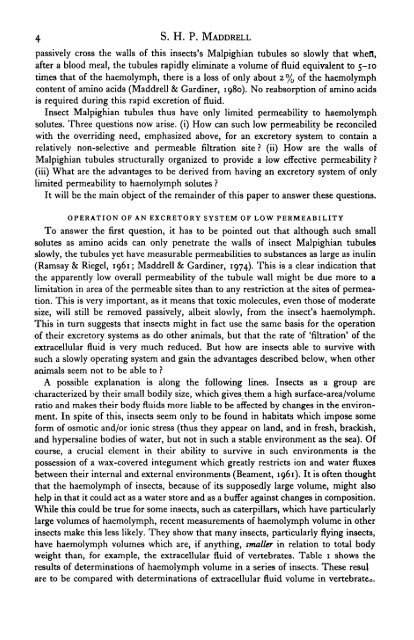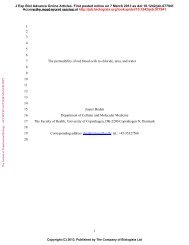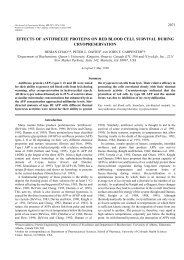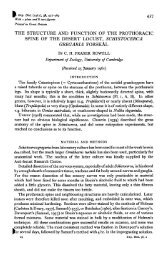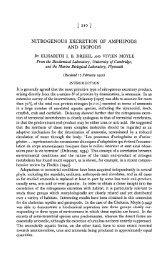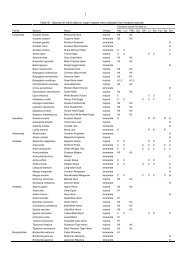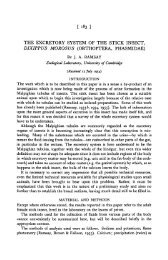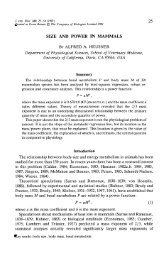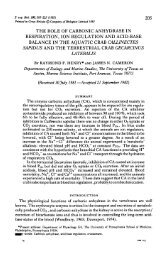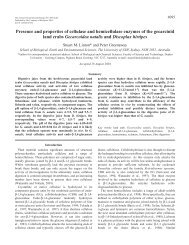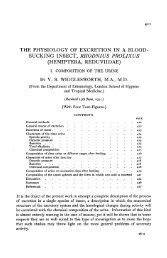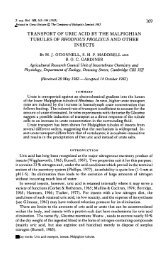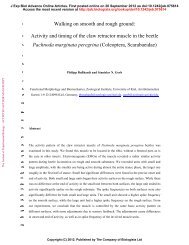the functional design of the insect excretory system - The Journal of ...
the functional design of the insect excretory system - The Journal of ...
the functional design of the insect excretory system - The Journal of ...
You also want an ePaper? Increase the reach of your titles
YUMPU automatically turns print PDFs into web optimized ePapers that Google loves.
4 S. H. P. MADDRELL<br />
passively cross <strong>the</strong> walls <strong>of</strong> this <strong>insect</strong>s's Malpighian tubules so slowly that whefl,<br />
after a blood meal, <strong>the</strong> tubules rapidly eliminate a volume <strong>of</strong> fluid equivalent to 5-10<br />
times that <strong>of</strong> <strong>the</strong> haemolymph, <strong>the</strong>re is a loss <strong>of</strong> only about 2 % <strong>of</strong> <strong>the</strong> haemolymph<br />
content <strong>of</strong> amino acids (Maddrell & Gardiner, 1980). No reabsorption <strong>of</strong> amino acids<br />
is required during this rapid excretion <strong>of</strong> fluid.<br />
Insect Malpighian tubules thus have only limited permeability to haemolymph<br />
solutes. Three questions now arise, (i) How can such low permeability be reconciled<br />
with <strong>the</strong> overriding need, emphasized above, for an <strong>excretory</strong> <strong>system</strong> to contain a<br />
relatively non-selective and permeable nitration site ? (ii) How are <strong>the</strong> walls <strong>of</strong><br />
Malpighian tubules structurally organized to provide a low effective permeability ?<br />
(iii) What are <strong>the</strong> advantages to be derived from having an <strong>excretory</strong> <strong>system</strong> <strong>of</strong> only<br />
limited permeability to haemolymph solutes ?<br />
It will be <strong>the</strong> main object <strong>of</strong> <strong>the</strong> remainder <strong>of</strong> this paper to answer <strong>the</strong>se questions.<br />
OPERATION OF AN EXCRETORY SYSTEM OF LOW PERMEABILITY<br />
To answer <strong>the</strong> first question, it has to be pointed out that although such small<br />
solutes as amino acids can only penetrate <strong>the</strong> walls <strong>of</strong> <strong>insect</strong> Malpighian tubules<br />
slowly, <strong>the</strong> tubules yet have measurable permeabilities to substances as large as inulin<br />
(Ramsay & Riegel, 1961; Maddrell & Gardiner, 1974). This is a clear indication that<br />
<strong>the</strong> apparently low overall permeability <strong>of</strong> <strong>the</strong> tubule wall might be due more to a<br />
limitation in area <strong>of</strong> <strong>the</strong> permeable sites than to any restriction at <strong>the</strong> sites <strong>of</strong> permeation.<br />
This is very important, as it means that toxic molecules, even those <strong>of</strong> moderate<br />
size, will still be removed passively, albeit slowly, from <strong>the</strong> <strong>insect</strong>'s haemolymph.<br />
This in turn suggests that <strong>insect</strong>s might in fact use <strong>the</strong> same basis for <strong>the</strong> operation<br />
<strong>of</strong> <strong>the</strong>ir <strong>excretory</strong> <strong>system</strong>s as do o<strong>the</strong>r animals, but that <strong>the</strong> rate <strong>of</strong> 'filtration' <strong>of</strong> <strong>the</strong><br />
extracellular fluid is very much reduced. But how are <strong>insect</strong>s able to survive with<br />
such a slowly operating <strong>system</strong> and gain <strong>the</strong> advantages described below, when o<strong>the</strong>r<br />
animals seem not to be able to ?<br />
A possible explanation is along <strong>the</strong> following lines. Insects as a group are<br />
characterized by <strong>the</strong>ir small bodily size, which gives <strong>the</strong>m a high surface-area/volume<br />
ratio and makes <strong>the</strong>ir body fluids more liable to be affected by changes in <strong>the</strong> environment.<br />
In spite <strong>of</strong> this, <strong>insect</strong>s seem only to be found in habitats which impose some<br />
form <strong>of</strong> osmotic and/or ionic stress (thus <strong>the</strong>y appear on land, and in fresh, brackish,<br />
and hypersaline bodies <strong>of</strong> water, but not in such a stable environment as <strong>the</strong> sea). Of<br />
course, a crucial element in <strong>the</strong>ir ability to survive in such environments is <strong>the</strong><br />
possession <strong>of</strong> a wax-covered integument which greatly restricts ion and water fluxes<br />
between <strong>the</strong>ir internal and external environments (Beament, 1961). It is <strong>of</strong>ten thought<br />
that <strong>the</strong> haemolymph <strong>of</strong> <strong>insect</strong>s, because <strong>of</strong> its supposedly large volume, might also<br />
help in that it could act as a water store and as a buffer against changes in composition.<br />
While this could be true for some <strong>insect</strong>s, such as caterpillars, which have particularly<br />
large volumes <strong>of</strong> haemolymph, recent measurements <strong>of</strong> haemolymph volume in o<strong>the</strong>r<br />
<strong>insect</strong>s make this less likely. <strong>The</strong>y show that many <strong>insect</strong>s, particularly flying <strong>insect</strong>s,<br />
have haemolymph volumes which are, if anything, smaller in relation to total body<br />
weight than, for example, <strong>the</strong> extracellular fluid <strong>of</strong> vertebrates. Table 1 shows <strong>the</strong><br />
results <strong>of</strong> determinations <strong>of</strong> haemolymph volume in a series <strong>of</strong> <strong>insect</strong>s. <strong>The</strong>se resul<br />
are to be compared with determinations <strong>of</strong> extracellular fluid volume in vertebrate^.


